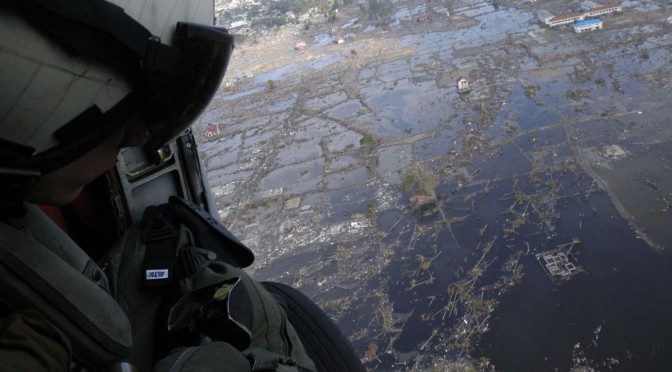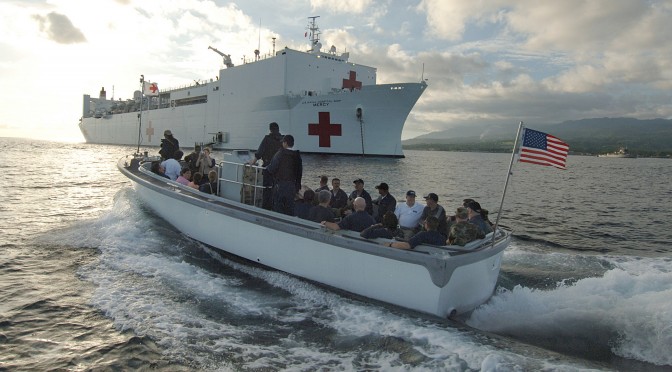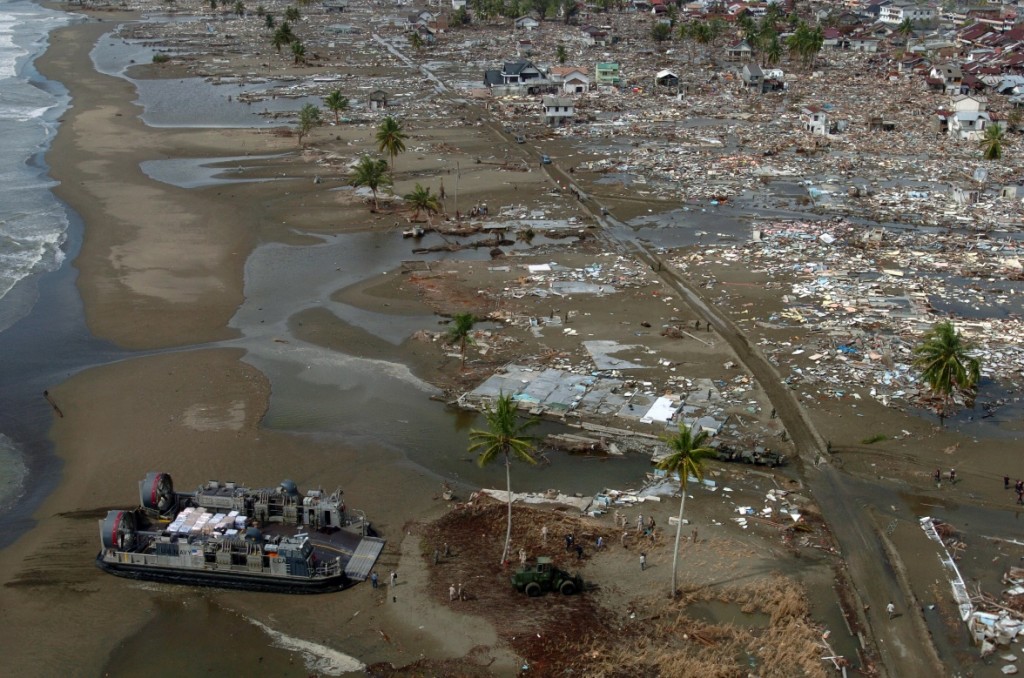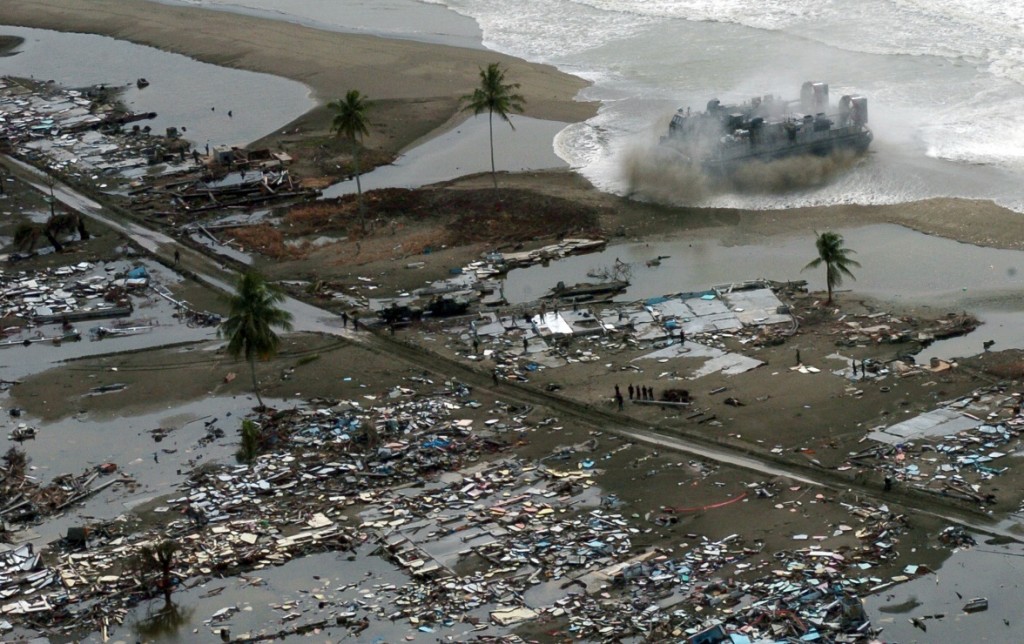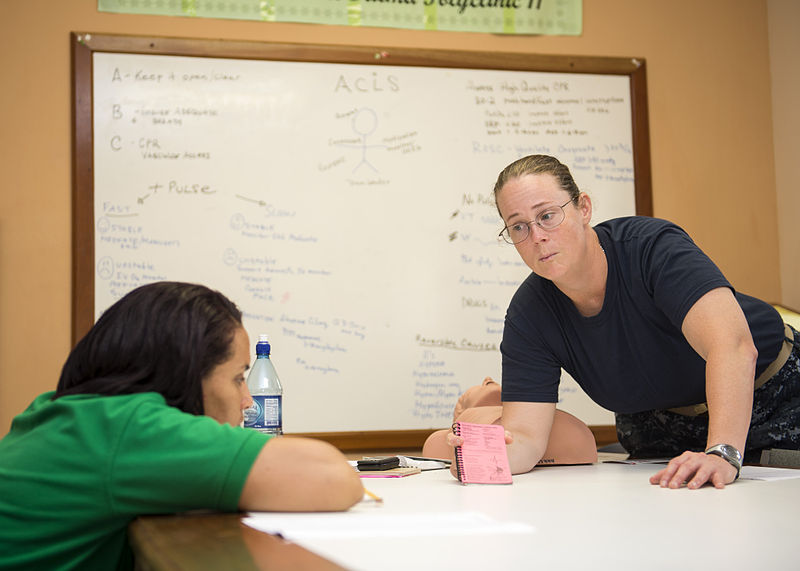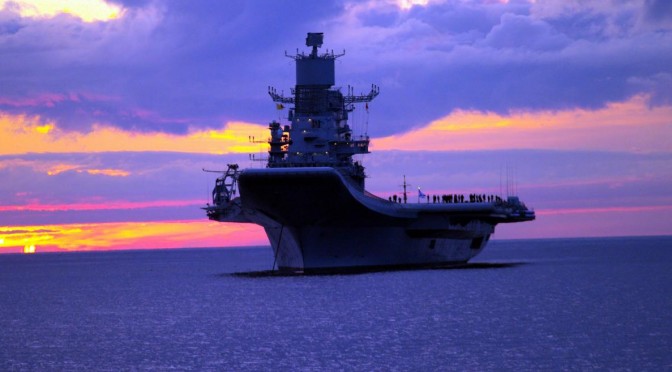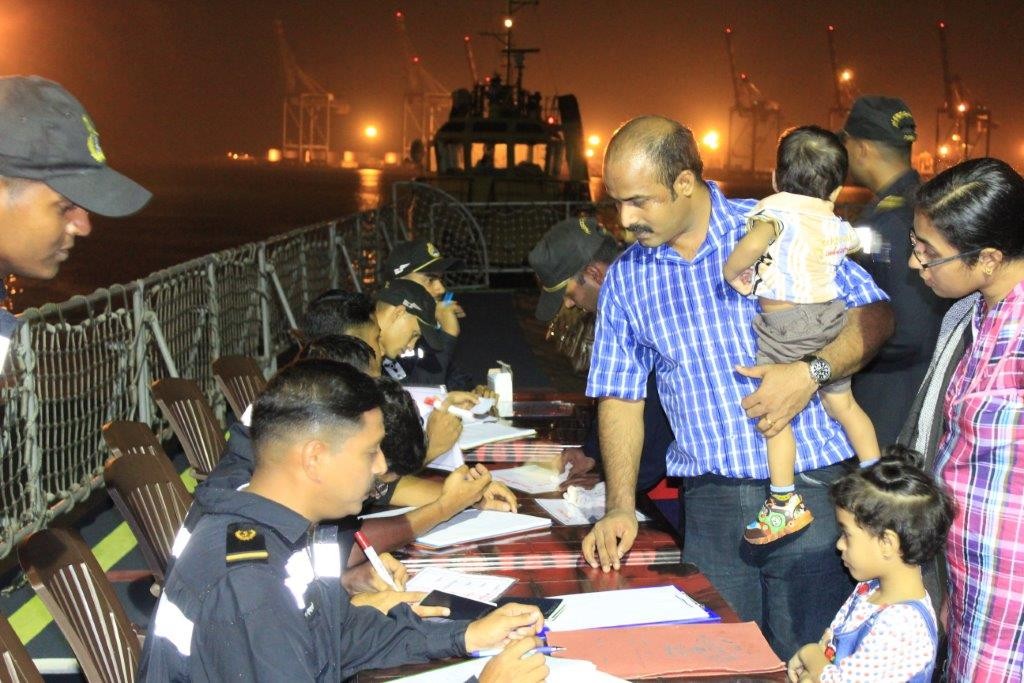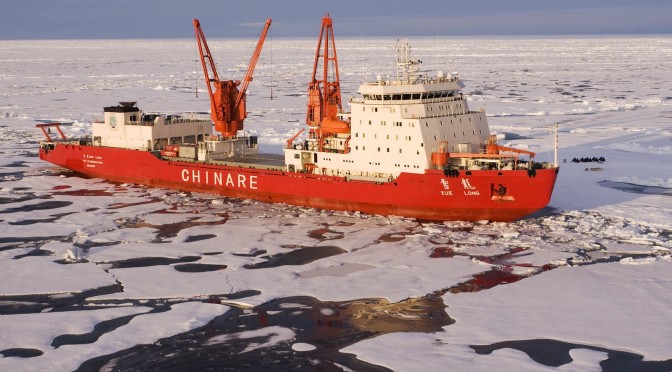By CDR Andrea H. Cameron
In less than a century, the notion of humanitarian assistance evolved from a global rarity to a significant component of international relations. Military involvement has escalated so much that brief mentions in early strategy documents have turned into entire sections and mission areas dedicated to the subject. From 1970 to 2000, the U.S. military was diverted from its regular schedule to conduct humanitarian assistance/disaster relief (HA/DR) operations 366 times.[1] This leads to so many questions around the issue of military involvement in HA/DR. For example, what does the United States gain from doing HA/DR? With so many more serious priorities, why do we need to examine HA/DR? A professional warfighter may say they specialize in destroying things, not fixing them, therefore concluding that HA/DR should not be in the military skillset. Overall, what is the future of the military’s role in HA/DR?
To help answer these questions, we will have to look at the connection between American strategy and maritime strategy. Throughout history, maritime forces were solely defined by their hard power capability. The focus of maritime strategy has historically been the protection of commerce, denial of resources to an enemy, and enabling of ground forces.[2][3] Previous maritime strategists like Alfred Thayer Mahan, Sir Halford Mackinder, and Julian Corbett make no mention of using maritime forces for assistance related missions. However, the grand strategy of American primacy is founded on maintaining the liberal international order, protecting open commerce and international trade, and spreading American values of freedom and self-determination. Additionally, U.S. interests remain inextricably linked to the peace and security of other countries. With globalization, a disruption to the international system like a natural disaster challenges the security of the United States and the rest of the world—particularly the highly interconnected economic system. And getting back to our maritime strategists–that economic system is primarily safeguarded by the forward presence of U.S. maritime forces. It is those same forces that are well positioned to respond to a natural disaster and minimize the disruption through relief operations. It is the convergence of significant economic interests, international responsibility to the world order, and the global humanitarian values that provides strategic motivations for continued involvement in HA/DR operations.
Humanitarian assistance/disaster relief has emerged as a noteworthy piece of U.S. national strategy. The critical turning point was the strategic, political, and military lessons learned from the 2004 Indian Ocean earthquake and tsunami. As a result, HA/DR operations have elevated not only within U.S. strategy, but also received similar attention from navies around the world. For the first time, HA/DR was formally named a maritime core capability in the 2007 Cooperative Strategy for the 21st Century Seapower. While the continued justifications for military involvement in HA/DR vary greatly, the increasing emphasis on this subset of the mission has undeniably grown. Understanding the early military contributions to humanitarian assistance, studying what happened in 2004, and examining the strategic guidance afterward reflects the monumental strategic shift of using hard power assets for this soft power mission. This article captures why HA/DR rose to such a high place in national and military strategy and why the military will most likely increase involvement in HA/DR missions in the future.
Military Support of HA/DR Before 2004
The United States uses all instruments of national power to support U.S. strategic goals. As an instrument of national power, the military can bring significant capability to a disaster relief operation beyond the host nation and international community’s capacity. While all services can and do play a role in humanitarian assistance/disaster relief, the Navy and Marine Corps are uniquely positioned for this mission. Largely self-sustainable, forward deployed, flexible, and trained for mobilization of sea-to-shore assets, the maritime services can provide assistance quickly, on location, and without exacerbating the ashore capacity constraints. Additionally, strategic lift, medical support, construction battalions, air traffic controllers, and maritime pre-positioning ships all contribute to HA/DR.
With the end of the Cold War, the 1990s saw the rise of naval presence as a mission set in and of itself. Peace and economic prosperity were facilitated by developing and maintaining regional stability through the Navy’s forward presence. Also, forward presence could shift from unobtrusive peacetime operations to power projection in short order demonstrating United States commitment while simultaneously promoting American interests.[4] The Navy and Marine Corps evolved as the key crisis responder in a variety of military-operations-other-than-war. Planning and conducting HA/DR was included in this broader category.[5] Reflecting U.S. values, the Naval Operational Concept of 1997 stated: “When disaster strikes, we provide humanitarian assistance, showing American compassion in action.”[6] HA/DR also provided an opportunity to work with joint and coalition partners to improve operational cohesion and mutual trust. While HA/DR was by no means predominant, it was routinely mentioned in naval guidance as one of the operational capabilities of the service.
After the terrorist attacks of September 11, 2001, President Bush increased humanitarian assistance particularly in support of spreading democracy throughout the world.[7] In pursuit of the global war on terror, aid was provided to states for improving governance—particularly in areas with ungoverned spaces in which terrorists could dwell. Military-conducted humanitarian assistance was considered part of the preventative actions in the active, layered defense of the United States homeland.[8] After 9/11, military involvement in humanitarian assistance shifted to preventative measures in the fight against terrorism. While these are two very different justifications for humanitarian assistance, the events of the 2004 Indian Ocean earthquake and tsunami significantly altered the role of humanitarian assistance/disaster relief in U.S. strategy and for the military.
2004 Indian Ocean Earthquake and Tsunami
At 7:59 A.M. on December 26, 2004, a 9.15 magnitude earthquake occurred off the western coast of the Sumatra island of Indonesia in the Indian Ocean. During the earthquake, the seabed rose by as much as 16 feet in some areas—displacing an estimated seven cubic miles of water and causing tsunamis across the Indian Ocean. In total, there were over 225,000 reported fatalities and missing people and nearly 1.2 million displaced people.[9] The worst damage occurred in the Banda Aceh province on an island of Sumatra, Indonesia, resulting in 163,000 people dead or missing and over half a million displaced.[10] Basic infrastructure like shelter, medical capacity, transportation routes, emergency services, power, communication, and sanitation were lost. The main highway connecting Banda Aceh to the rest of the island was washed away, cutting off the major city from land-based support. Thailand also reported 8,000 dead or missing.[11] Sri Lanka reported 38,000 dead and missing and 500,000 displaced, and India reported 16,000 dead or missing.[12] Other countries impacted include Maldives, Seychelles, Somalia, Tanzania, Kenya, and one fatality recorded as far away as South Africa. Overall, this one event had a significant impact on all countries around the Indian Ocean and for a variety of reasons had a global affect as well.
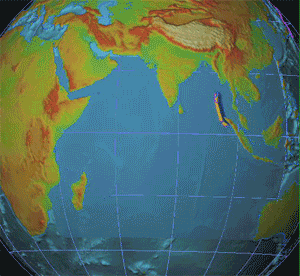
President George W. Bush made the first public commitment of support three days after the earthquake and tsunami.[13] On December 29, 2004, he announced the initial aid contribution of $15 million and military assistance. As more accurate reports came in, he increased the aid to $35 million on the same day.[14] While the primary responses of state department and defense department were already taking action to coordinate efforts within the region, the perception of delayed global leadership put both President Bush and Secretary of State Colin Powell on the defensive. The United Nations Emergency Relief Coordinator, Jan Egeland, openly accused the United States of being stingy with respect to the global crisis.[15] Although massive mobilization was occurring to support relief efforts, the president was losing ground with international public relations and the perception of weak U.S. leadership. By December 31, based on more accurate reports of the damage, President Bush increased the United States contribution to $350 million.
The American response far out-weighed the contributions of any other state, however, the political handling of the situation displayed a perceived passivity, lack of global leadership, and general lack of respect for human life abroad. While untrue, there was the perception that American actions did not match American values. As the United States proceeded in coordinating the global response until the international humanitarian system became established, President Bush consistently had to battle the negative global perception that happened at the start of the event. By the end the United States government donated $950M and American citizens donated $700M to charities.[16]
American Military Response
The U.S. military response was immediate. While the State Department holds the lead in foreign disaster relief, geographic combatant commanders have the ability to act in a window of 72 hours without President/Secretary of Defense approval, provided the combatant commander coordinated with the local Chief of Mission.[17] Based on this authority, the United States military response started before the political response in the 2004 Indian Ocean earthquake and tsunami. Immediately upon notification of the tsunamis, Admiral Thomas Fargo of Pacific Command (PACOM) and Admiral Walter Doran of Pacific Fleet (PACFLT) authorized ship movements toward the region—particularly off the coast of Indonesia.[18] Soon thereafter, at the direction of the President, the Secretary of Defense authorized PACOM to establish a disaster response operation: Operation Unified Assistance.[19] By December 28, before President Bush publically announced the first proclamations of U.S. support, PACOM already established Joint Task Force 536 (JTF 536) and appointed USMC Lieutenant General Robert Blackman from 3rd Marine Expeditionary Force to lead the efforts. By December 30, the first C-130s arrived and December 31 the first helicopters arrived. The headquarters was up and running by January 2—one week after the event. On January 3, the JTF evolved to Combined Support Force 536 (CSF 536) to include and coordinate the assets brought forth from other nations. Australia brought 900 troops to Aceh province, Japan contributed two ships and 350 troops, Singapore provided tank landing ships and helicopters, and Britain, Germany and China supplied medical teams.[20] By January 5, a week and a half after the event, the United States had 25 ships, 45 fixed-wing aircraft, and 58 helicopters and a total of over thirteen thousand military personnel supporting the HA/DR mission.[21]

Maritime support was vital to this HA/DR mission. The concept of sea-basing was put to the test since Banda Aceh lacked the land based connection and U.S. ships with supplies were available right off the coast. This kept the U.S. military footprint ashore to a minimum, while still delivering significant amounts of aid on short notice. Aid was loaded onto aircraft and maritime pre-positioning ships coming from Japan, Guam, and Singapore staged with relief supplies. Those ships would transfer the supplies to the other ships off the coast and then return for more supplies. Then, the carrier strike group and amphibious readiness group would send supplies ashore using helicopters and Landing Craft Air Cushions (LCAC). The majority of the personnel working relief operations never had to be housed or fed ashore. Operation Unified Assistance proved the operational merit of sea-basing.
The first week focused on the delivery of food and water, rescuing survivors in isolated, cut off areas and delivering medical aid. By the second week, clearing rubble, demolition, tearing down damaged buildings, and salvaging materials to rebuild became the major focus. Most immediate needs were met by mid-February and international and non-governmental organizations were now in place to continue the delivery of aid. CSF 536 ceased operations on February 14, 2005. The total military operation lasted a month and a half, but delivered over twenty-four million pounds of relief supplies and performed 19,512 medical procedures.[22][23]
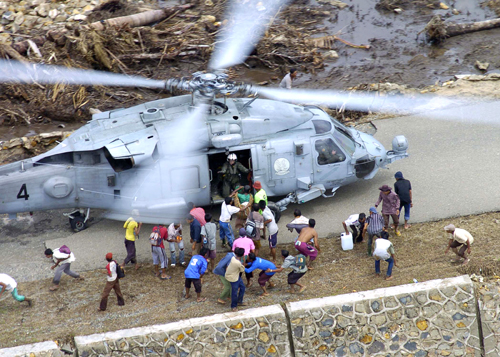
Lessons Learned and After Effects
Numerous lessons learned emerged from the experience with the 2004 earthquake and tsunami. First, the greatest lesson learned by the United States was to better manage the politics and public relations. While the state and defense departments responded with immediacy, the delayed public statements by President Bush gave the impression that the United States would not live up to its values nor lead in a time of need. In the end, the United States, particularly the military, displayed leadership and coordination in a time of crisis and provided solid support to the overwhelmed host nations, United Nations, and governmental and non-governmental organizations all trying to help. The strength of naval capability and coordination also proved the sea-basing concept in support of humanitarian missions in sensitive areas. Another key result for the United States was a reassurance of military support in the future to allied countries in Asia as well as an improved relationship with Indonesia. After Operation Unified Assistance, the United States ended an embargo on military goods and normalized diplomatic relations with Indonesia.[24] U.S. actions also countered the anti-Muslim perception created by the Iraq War and increased public opinion of the U.S. in Indonesia by 39%[25] Internationally, key lessons included education, preventative measures, and pre-coordination. Finally, given that the same event affected so many countries, this showed that countries that had conducted previous exercises and coordination events to prepare for a natural disaster fared better in responding to an actual disaster.
These lessons permanently changed the perception of state response to HA/DR. Internationally, the norms of humanitarianism and state-to-state collaboration had evolved to such a degree that states are expected to offer assistance in times of need. The minimal response of China, a rising international actor, was internationally ridiculed. The delayed political response of United States signaled strategic weakness in global leadership, holes in the security umbrella, willingness to come to the assistance of allies, gaps in forward presence supporting the economic system, and a compromise of U.S. values. Whether true or not, and most of this is untrue, the United States became acutely aware that the proper handling of this type of HA/DR mission has significant strategic consequences.
Shortly after the 2004 Indian Ocean earthquake and tsunami, two major events also supported a changed mindset for humanitarian assistance/disaster relief. On August 29, 2005, Hurricane Katrina struck the Gulf coast of the United States resulting in over 1,800 fatalities and $125 billion in economic damages. Then, on October, 8, 2005, a devastating earthquake in Pakistan killed over 73,000 people and displaced 500,000, prompting another large-scale U.S. HA/DR response supported by the military. Both events created a heightened awareness for the impact of natural disasters and reinforced the lessons of the 2004 Indian Ocean earthquake and tsunami. National strategy started to reflect the new approach.
Impact on United States Strategy
This section chronicles the various ways HA/DR permeated U.S. strategic guidance after the 2004 Indian Ocean earthquake and tsunami. President George W. Bush’s 2006 National Security Strategy listed humanitarian assistance in a stand-alone section at the end of the document addressing international engagement and globalization. Factors like trade, investment, information, and technology were changing the geopolitical landscape in ways that could threaten national security. This strategy placed humanitarian disasters in a category with failed states and ungoverned areas that could become safe havens for terrorists. [26] While climate change was not specifically mentioned, environmental destruction (man-made or natural) addressed these disasters. The tone was matter-of-fact, that the capacities of local governments may be overwhelmed requiring a larger international response and the “full exercise of national power, up to and including traditional security instruments.” [27] United States assistance demonstrated global leadership, unattended events could threaten national security, the U.S. was willing to create new partnerships, and had ardent desire for preparedness and improved coordination.
The 2006 Quadrennial Defense Review also included an assessment of the 2004 Indian Ocean response among several other humanitarian assistance related items. This document connected military support of humanitarian assistance with everything from large scale disaster relief operations, to promoting regional stability in general, stability and reconstruction operations specifically, working with international allies and partners, promoting U.S. values abroad, and homeland security after Hurricane Katrina. [28] Fighting the long war continued to include humanitarian and early prevention measures to keep America safe. The QDR stated:
“U.S. forces continue to conduct humanitarian assistance and disaster relief operations around the globe. Preventing crises from worsening and alleviating suffering are goals consistent with American values. They are also in the United States’ interest. By alleviating suffering and dealing with crises in their early stages, U.S. forces help prevent disorder from spiraling into wider conflict or crisis. They also demonstrate the goodwill and compassion of the United States.”[29]
It was the 2007 Cooperative Strategy for 21st Century Seapower, signed by the service chiefs of the Navy, Marine Corps, and Coast Guard, that fully elevated humanitarian assistance and disaster response to one of the six core capabilities of the sea services.[30] The strategy in general placed a great emphasis on the maritime role in maintaining the global economic system and international order—reflecting a broader strategic perspective compared to a typical threat-based approach. HA/DR now held its own place amongst the traditional maritime capabilities of forward presence, deterrence, sea control, power projection, and maritime security.
In 2010, President Barack Obama’s National Security Strategy broadly addressed both climate change and humanitarian assistance. Not only did this reflect the change in leadership, but also the devastating effect of the 2010 Haiti earthquake that resulted in over 222,000 fatalities. The new strategy included humanitarian assistance as part of promoting dignity through meeting basic needs and broad international cooperation for global challenges. For the first time, a national security document reflected the Intergovernmental Panel on Climate Change (IPCC) reports that portend that as a result of climate change, natural disasters will be increasing in frequency and effect.[31][32]
Follow-on strategy documents continue to reiterate the humanitarian assistance mission in a wide variety of contexts. Secretary Robert Gates’ 2010 Quadrennial Defense Review connected HA/DR with climate change and energy security as well as regional destabilization as a result of climate change. The 2011 National Military Strategy addressed HA/DR in strengthening international and regional security—focusing on the joint, interagency, and theater security cooperation aspects before, during, and after an event.[33] The 2012 Defense Strategic Guidance includes HA/DR domestically in support of civil authorities and internationally to provide military response options to major events.[34] By the 2014 Quadrennial Defense Review, HA/DR was listed as one of twelve mission priorities requiring military advice to the President. The QDR also categorized HA/DR as part of the power projection capability of the military.[35] In President Obama’s 2015 National Security Strategy, HA/DR is also mentioned in the context of building our national defense, building partner capacity, and confronting climate change. [36] As the documents show, while the HA/DR mission is a constant, the highlighted reasons for doing it keep shifting.
In the 2015 Cooperative Strategy for 21st Century Seapower, HA/DR is included among the naval functions of defending the homeland, deterring conflict, responding to crises, defeating aggression, protecting the maritime commons, and strengthening partnerships.[37] Following the 2014 QDR categorization of HA/DR as power projection, HA/DR is a “smart power” mission of power projection highlighting the use of military forces as an element of national power for diplomatic, informational, and also economic ends. The HA/DR segment highlights the 2010 Haiti earthquake response, 2011 earthquake/tsunami in Japan, and the 2013 typhoon Haiyan response in the Philippines. The maritime strategy emphasized the increased number of large scale events and the corresponding importance of HA/DR to maritime strategy.
So Why Do HA/DR?
Several trends converge that keep humanitarian assistance/disaster relief on the agenda. First and foremost, as learned after the 2004 Indian Ocean earthquake and tsunami response, if the United States is going to protect strategic, political, economic, and ideological interests abroad, then we must employ all instruments of national power to support HA/DR missions. The consequences of not doing so invite too much risk to destabilizing the current world order. Assisting in response and recovery support U.S. interests by rebuilding economic trade capacity, reassuring allies, shoring up ungoverned spaces that destabilize regions and germinate terrorist safe havens, and living up to the American values. The number of large scale natural disasters continues to escalate since the 2004 earthquake/tsunami and climate change scientists predict increased incidences and severity of natural disasters. Whether HA/DR is a derivative of forward presence or an embedded capability of power projection, whether it is labeled environmental destruction or climate change, whether it is to fight terrorism or promote broad international cooperation for global challenges—the evidence shows that HA/DR will remain a mission for the armed services no matter who is leading the country. Whatever the justification for doing HA/DR operations, it will continue to support U.S. interests and the strategic consequences of getting it wrong are too great. So, let’s do our part in doing it better!
Commander Andrea H. Cameron is a Permanent Military Professor in the National Security Affairs Department teaching policy analysis. She is also a member of the NWC Civilian-Military Humanitarian Response Program (HRP) which partners with leading universities and humanitarian organizations in order to advance civilian-military engagement and coordination during complex emergencies and disasters.
[1] W. Eugene Cobble, H.H. Gaffney, Dmitry Gorenberg. For the Record: All U.S. Forces’ Responses to Situations, 1970-2000 (Alexandria: Center for Naval Analyses Corporation, 2005).
[2] Alfred Thayer Mahan. The Influence of Seapower on History (New York: Dover Publications, Inc., 1890).
[3] Julian S. Corbett. Some Principles of Maritime Strategy (London: Longmans, Green and Co., 1918)
[4] “…From the Sea” reprinted in U.S. Naval Strategy in the 1990s, ed. John B. Hattendorf (Newport: Naval War College Press, 2006) p 91-92. Retrieved from https://www.usnwc.edu/Publications/Naval-War-College-Press/-Newport-Papers/Documents/27-pdf.aspx
[5] Naval Warfare (Naval Doctrine Publication 1) reprinted in U.S. Naval Strategy in the 1990s, ed. John B. Hattendorf (Newport: Naval War College Press, 2006) p 115-116.
[6] “The Naval Operational Concept,” signed by Chief of Naval Operations Admiral Jay L. Johnson, reprinted in U.S. Naval Strategy in the 1990s, ed. John B. Hattendorf (Newport: Naval War College Press, 2006) p 163.
[7] National Security Strategy 2002, signed by President George W. Bush.
[8] National Defense Strategy 2005, signed by Secretary of Defense Donald H. Rumsfeld, p 12.
[9] Office of U.S. Foreign Disaster Assistance (OFDA) Annual Report for Fiscal Year 2005. (Washington, D.C., U.S. Agency for International Development, 2005), 15. Retrieved from http://pdf.usaid.gov/pdf_docs/PDACH800.pdf on 18 October 2014.
[10] OFDA Annual Report 2005, p 18.
[11] OFDA Annual Report 2005, p 25.
[12] OFDA Annual Report 2005, p 17 and p 22.
[13] Bruce A. Elleman, Waves of Hope: The U.S. Navy’s Response to the Tsunami in Northern Indonesia (Newport: Naval War College Press, 2007), p 22.
[14] Elleman, Waves of Hope,, p 10.
[15] Elleman, Waves of Hope,, p 21.
[16] Elleman, Waves of Hope, p 101.
[17] Department of Defense Directive 5100.46. Foreign Disaster Relief (FDR). Signed by Ashton B. Carter, Assistant Secretary of Defense on July 6, 2012.
[18] Elleman, Waves of Hope, p 28.
[19] Elleman, Waves of Hope, p 28.
[20] Elleman, Waves of Hope, p 9.
[21] Wall of Water: U.S. Troops Aid Tsunami Victims. Department of Defense Year in Review 2005. Retrieved from http://www.defense.gov/home/features/2006/2005yearinreview/article2.html on December 17, 2014.
[22] Elleman, Waves of Hope, p 92.
[23] Wall of Water.
[26] National Security Strategy 2006, signed by President George W. Bush, p 15.
[27] National Security Strategy 2006, p 47-48.
[28] Quadrennial Defense Review 2006, signed by Secretary of Defense Donald H. Rumsfeld, p 12-13.
[29] Quadrennial Defense Review 2006, p 14.
[30] Cooperative Strategy for 21st Century Seapower-2007, signed by Commandant of the Marine Corps, General James T. Conway, Chief of Naval Operations Admiral Gary Roughead, and Commandant of the Coast Guard, Admiral Thad W. Allen, p 14.
[31] IPCC, 2007: Climate Change 2007:The Physical Science Basis. Contribution of Working Groups I to the Fourth Assessment Report of the Intergovernmental Panel on Climate Change [Core Writing Team, Pachauri, R.K and Meyer, L.(eds.)]. IPCC, Geneva, Switzerland.
[32] IPCC, 2007: Climate Change 2007:Impacts, Adaptation and Vulnerability. Contribution of Working Groups II to the Fourth Assessment Report of the Intergovernmental Panel on Climate Change [Core Writing Team, Pachauri, R.K and Meyer, L.(eds.)]. IPCC, Geneva, Switzerland.
[33] National Military Strategy 2011, signed by the Chairman of the Joint Chiefs of Staff, Admiral Michael G. Mullen, p 15.
[34] Defense Strategic Guidance 2012, signed by President Barack Obama, p 6.
[35] Quadrennial Defense Review 2014, signed by Secretary of Defense Chuck Hagel, p 60-61.
[36] National Security Strategy 2015, signed by President Barack Obama, p 7.
[37] Cooperative Strategy for 21st Century Seapower-2015, signed by Commandant of the Marine Corps, General Joseph F. Dunford, Jr., Chief of Naval Operations Admiral Jonathan W. Greenert, and Commandant of the Coast Guard, Admiral Paul F. Zukunft, p 19.

